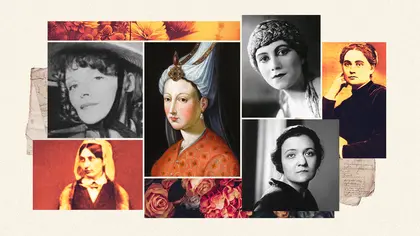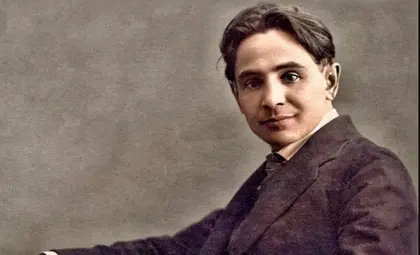The spy who was most generously paid for his work in the lead up to World War II, a handsome pilot, and resident of Poland under Nazi occupation. The only spy in the world to get a complete plan of concentration of hostile armed forces. The intelligence services of three countries made claims on him: Germany, Poland and the USSR. JERZY KSAWERY FRANCISZEK SOSNOWSKI, a.k.a. “Baron Ritter von Nalecz”, aka “Ritter von Nalecz.”
A SPY-SEDUCER
Sosnowski was born in 1896. He graduated from the Lviv gymnasium (secondary school), a cavalry academy and the officer machine-gunner course, and then served in the Austro-Hungarian and later Polish armies. After seducing the wife of his regiment’s commander, who then declared his intention to kill the offender, this Casanova from Lviv drew the attention of army intelligence. After having received the necessary training, in 1926 he decided to “escape” and became a resident of Germany. In fact, he had become a spy. The spy implemented the widely known “honey trap”: he seduced women and then used them. In this way he created a very effective network of informants.
JOIN US ON TELEGRAM
Follow our coverage of the war on the @Kyivpost_official.
HELLO THERE, HERR SPY!
On May 10, 1932, the popular Berliner Tribune published a sensational article under the screaming headline: “Who is Captain Sosnowski?” The author was the countess von Boholz, who, despite her fervent desire, did not manage to properly “connect” with the playboy. She argued that the aristocrat was not really the person he pretended to be. She also demonstrated the facts she had found out. Out of jealousy, the countess released the name of Benita von Falkenhayn, trying to indicate that she was a mistress and informant of Sosnowski.

Sahaidachny: Ukrainian Leader Whose Cossacks Saved Europe From Ottomans
Benita worked as a secretary in the military staff and through her husband was a relative of the well-known General von Falkenhayn. Law enforcement officers of what was then the Weimar Republic (Hitler came to power a year later) interpreted the accusatory publication as just another piece gossip from the tabloid press. And for three more years, those who knew Sosnowski jokingly greeted him with nothing but “Hello there, Herr Spy!”, so he invariably replied “Sic transit gloria mundi” (thus passes the world’s glory).
SOSNOWSKI’S HAREM
For more than seven years, Sosnowski was doing brilliantly: secret German papers were regularly sent to Warsaw. Military historians later called the “Harem of Sosnowski” the most effective spy network against Germany. Here are just the most sensational successes of his network:
- a complete scheme of the enemy’s battleplan (plan “A”).
- data on the close military cooperation between Moscow and Berlin, including the secret classes for German pilots and tank officers held near Lipetsk.
- German attack plans for France and Poland. During his life, the elegant and handsome Sosnowski cynically combined business with pleasure. It is difficult even to say what came first for him: the pleasures of seduction (by the way, he was a married man) or espionage. It is impossible to determine exactly how many “sex agents” he had.
The first recruitment into the “Harem of Sosnowski” happened in 1926, and the mark was Benita von Falkenhayn, a married woman. She not only passed secret documents on to him but also recruited some new “activists”. One of them was her school friend Irene von Jena who worked as a major in the Ministry of Defense at that time.
It was also thanks to Benita that Jerzy met Renate von Natzmer, who worked in the German Inspectorate of Tanks, Cavalry, and Motorized Troops. Subsequently, Renate became his best agent. Her haul was more than 200 papers stamped “Top Secret” and the key to the safe where the most important documents were kept. But the spy made a fatal mistake with the Hungarian dancer Lea Nyako. Because of her jealousy, she turned her “betrayer” in to the German special services. And although Maria de Camp (another “sex agent”) managed to warn her boss about the danger, the deadly game had reached its end.
On February 27, 1934, the Abwehr (German military intelligence) arrested Falkenhayn, Natzmer, Jena and Sosnowski. A year later, a sentence was pronounced: the first two were sentenced to death, the other two were punished with life imprisonment. However, the lover and traitor Lea Nyako was released from the courtroom. The fate of the several dozen other of “sex agents” from Sosnowski’s harem is still unknown.
OUT OF THE NAZI FRYING PAN, INTO THE COMMUNIST FIRE
Later, Warsaw got his spy back in exchanged for a group of captured German agents – but they sent him to prison right away, charged with treason. After three years of investigation he was sentenced with 15 years in prison. At the beginning of the Second World War, when the Germans invaded Poland, prison guards tried to quickly execute their charges. Sosnowski was wounded in one such shooting, but not fatally. Along with other refugees, the spy headed for the East, where he fell into the hands of Soviet intelligence. The latest testimony of Sosnowski’s life is from a Polish general who related (after he had emigrated to Britain) that he had been sitting in the same cell with the spy Jerzy in the Lubyanka (a Moscow prison). It was there, in 1942, that Sosnowski allegedly died of starvation.
However, there is another version: that the now-unlucky Sosnowski was eliminated by operatives of the “Dwojka” (The Second Department of Polish General Staff of Polish military intelligence): they believed that Sosnowski had also sold the German “Plan A” to the intelligence services of a number of countries, according to Benita von Falkenhayn’s testimony given in Berlin. So perhaps the Poles took revenge.
A CHOPPING BLOCK OF LOVE
The beautiful female spies who worked for Sosnowski also paid with their lives for working in his “harem”. Their execution took place several years before Sosnowski’s death. It was carried out in the courtyard of the Berlin House of Death (now the Plötzensee Memorial). The first was Renata von Natzmer. At the last moment, she lost her temper. The fräulein started yelling and even tried to run. The three assistants to the executioner were unable to securely hold the victim on the chopping block, which made the first strike of the axe unsuccessful.
Benita von Falkenhayn behaved quite differently. Before heading to the executioner, the Baroness addressed Sosnowski (his trial was still pending, but he was brought to his mistresses’ execution), saying: “I am glad to die for my new Motherland!” He nodded at her and blew a kiss. Benita climbed the scaffold on her own, measuring her steps firmly. She knelt. And what happened next even surprised the experienced executioner, who was dressed in an evening suit with a black mask. Before bowing her head, the Baroness put a photo of Sosnowski that she had managed to carry with her on the chopping block, so as to be able look at him at the last moment of her life.
Sosnowski was bereaved at the deaths of his mistresses. He was quoted in Time Magazine, in the August 16, 1936 issue: “I am haunted by the deaths of those women. Until I was released in an exchange of prisoners I had seen no human face for 14 months. My food was lowered to me by guards from a trap door. The tragic deaths of those two – my former associates – haunt me night & day and I can only attempt to gain peace through prayer for their souls”.
INTERESTING FACTS
During his year of fighting for Poland (1920- 1921), Sosnowski was awarded the Polish “Cross of Merit for Bravery” four times.
- Benita Falkenhayn and Renata Natzmer showed not only espionage skills, but also business instincts, inventing the new agents Lottie Lemmel and Isabella Laumer, who didn’t really exist. However, Sosnowski paid for their imaginary services on a regular basis, transferring funds through his resourceful helpers.
- The legendary Admiral Canaris took over the position of Abwehr chief because his predecessor, Conrad Patzig, was fired due to the scandal around the Sosnowski’s revelations.
- The leader of the German Communists, Ernst Telman was also in jail at the same time with our prisoner from Ukraine. They were even defended in court by the same lawyer.
- The representatives of the Ministry of Public Enlightenment and Propaganda were the only ones to be allowed to hear the sensational court case of the Lviv citizen.
- Sosnowski was the highest-paid intelligence officer: the Polish government paid him more than 1 million Reichsmarks, half of the funding of the whole operation he was involved in.
FROM THE DOSSIER OF JERZY SOSNOWSKI
- Sosnowski was born on December 4, 1896 in Lviv.
- He had a military background.
- He served in the Austro[1]Hungarian Army (1914- 1917), at the headquarters of the Polish Warsaw Corps (1917-1926), and as a Polish spy in Germany (1926-1934).
- After being arrested on suspicion of espionage he was imprisoned in Moabit prison (then the most infamous prison in Germany).
- A Berlin court sentenced Sosnowski to life imprisonment, but he was later exchanged for some captured German agents (1936).
- He died in 1942 in the USSR in unclear circumstances. The exact date of his death and where he is buried are unknown.
"Every spy thinks about luck. This is a thing that cannot be bought with money"- Jerzy Sosnowski.
This article by Nadiia Avramchuk and Mykola Sukhomozsky is reprinted with the publisher's permission from the book (UN)Celebrated Ukrainians Who Changed the Course of History, SAMIT-KNYHA, Kyiv, 2020.
You can also highlight the text and press Ctrl + Enter






